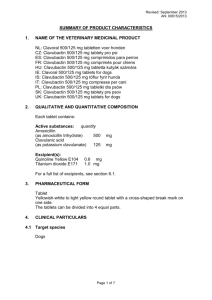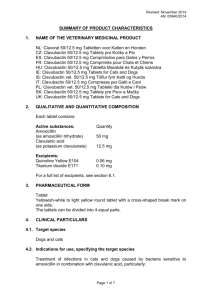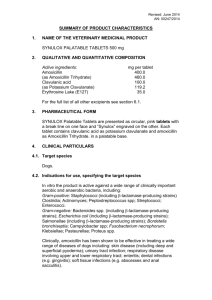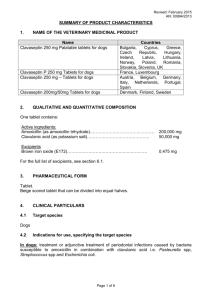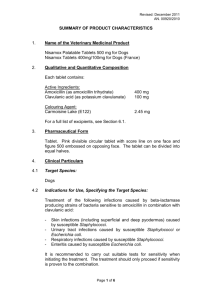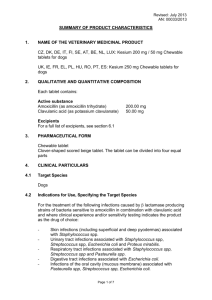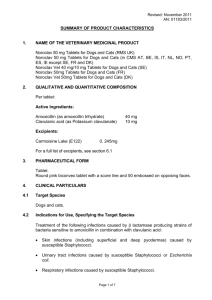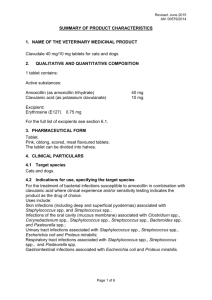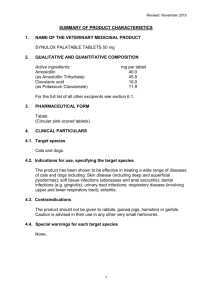Vm - Veterinary Medicines Directorate
advertisement
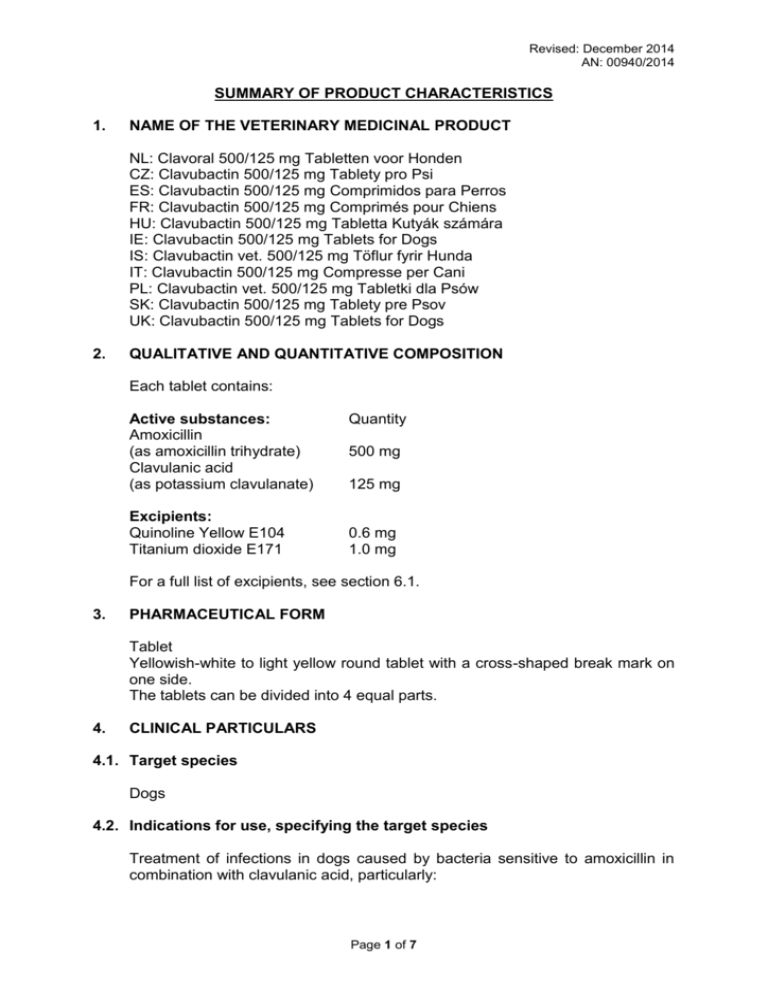
Revised: December 2014 AN: 00940/2014 SUMMARY OF PRODUCT CHARACTERISTICS 1. NAME OF THE VETERINARY MEDICINAL PRODUCT NL: Clavoral 500/125 mg Tabletten voor Honden CZ: Clavubactin 500/125 mg Tablety pro Psi ES: Clavubactin 500/125 mg Comprimidos para Perros FR: Clavubactin 500/125 mg Comprimés pour Chiens HU: Clavubactin 500/125 mg Tabletta Kutyák számára IE: Clavubactin 500/125 mg Tablets for Dogs IS: Clavubactin vet. 500/125 mg Töflur fyrir Hunda IT: Clavubactin 500/125 mg Compresse per Cani PL: Clavubactin vet. 500/125 mg Tabletki dla Psów SK: Clavubactin 500/125 mg Tablety pre Psov UK: Clavubactin 500/125 mg Tablets for Dogs 2. QUALITATIVE AND QUANTITATIVE COMPOSITION Each tablet contains: Active substances: Amoxicillin (as amoxicillin trihydrate) Clavulanic acid (as potassium clavulanate) Excipients: Quinoline Yellow E104 Titanium dioxide E171 Quantity 500 mg 125 mg 0.6 mg 1.0 mg For a full list of excipients, see section 6.1. 3. PHARMACEUTICAL FORM Tablet Yellowish-white to light yellow round tablet with a cross-shaped break mark on one side. The tablets can be divided into 4 equal parts. 4. CLINICAL PARTICULARS 4.1. Target species Dogs 4.2. Indications for use, specifying the target species Treatment of infections in dogs caused by bacteria sensitive to amoxicillin in combination with clavulanic acid, particularly: Page 1 of 7 Revised: December 2014 AN: 00940/2014 - - - Skin infections (including superficial and deep pyodermas) associated with Staphylococci (including beta-lactamase producing strains) and Streptococci. Urinary tract infections associated with Staphylococci (including betalactamase producing strains), Streptococci, Escherichia coli (including betalactamase producing strains), Fusobacterium necrophorum and Proteus spp. Respiratory tract infections associated with Staphylococci (including betalactamase producing strains), Streptococci and Pasteurellae. Digestive tract infections associated with Escherichia coli (including betalactamase producing strains) and Proteus spp. Infections of the oral cavity (mucous membrane) associated with Clostridia, Corynebacteria, Staphylococci (including beta-lactamase producing strains), Streptococci, Bacteroides spp (including beta-lactamase producing strains), Fusobacterium necrophorum and Pasteurellae. 4.3. Contraindications Do not use in animals with known hypersensivity to penicillin or other substances of the beta-lactam group. Do not use in serious dysfunction of the kidneys accompanied by anuria and oliguria. Do not use in rabbits, guinea pigs, hamsters, chinchillas or gerbils. Do not use in case of known resistance to the combination. 4.4. Special warnings for each target species None known. 4.5. Special precautions for use i) Special precautions for use in animals Official, national and regional antimicrobial policies with respect to the use of broad-spectrum antibiotics should be taken into account. Do not use in case of bacteria sensitive to narrow spectrum penicillins or to amoxicillin as single substance. It is advised that upon initiating therapy appropriate sensitivity testing is performed and that therapy is continued only after susceptibility to the combination has been established. Use of the product deviating from the instructions given in the SPC may increase the prevalence of bacteria resistant to the amoxicillin/clavulanate, and may decrease the effectiveness of treatment with β-lactam antibiotics. In animals with hepatic and renal failure, the dosing regimen should be carefully evaluated. Caution is advised in the use in small herbivores other than those in the section 4.3. Page 2 of 7 Revised: December 2014 AN: 00940/2014 ii) Special precautions to be taken by the person administering the veterinary medicinal product to animals Penicillins and cephalosporins may cause hypersensitivity reactions (allergy) following injection, inhalation, ingestion or skin contact. Hypersensitivity to penicillins may lead to cross-reactions to cephalosporins and vice versa. Allergic reactions to these substances may occasionally be serious. - Do not handle this product if you know you are sensitised, or if you have been advised not to work with such preparations. - Handle this product with great care to avoid exposure, taking all recommended precautions. - If you develop symptoms following exposure such as a skin rash, you should seek medical advice and show the doctor this warning. Swelling of the face, lips or eyes or difficulty with breathing are more serious symptoms and require urgent medical attention. - Wash hands after use. 4.6. Adverse reactions (frequency and seriousness) Mild gastrointestinal symptoms (diarrhoea, nausea and vomiting) may occur after administration of the product. Allergic reactions (skin reactions, anaphylaxia) may occasionally occur. In these cases, administration should be discontinued and a symptomatic treatment given. 4.7. Use during pregnancy, lactation or lay Laboratory studies in rats and mice have not produced any evidence of teratogenic or fetotoxic effects. No studies have been conducted in the pregnant and lactating dogs. Use only according to the benefit/risk assessment by the responsible veterinarian. 4.8. Interaction with other medicinal products and other forms of interaction Chloramphenicol, macrolides, sulfonamides, and tetracyclines may inhibit the antibacterial effects of penicillins. The potential for allergic cross-reactivity with other penicillins should be considered. Penicillins may increase the effect of aminoglycosides. 4.9. Amounts to be administered and administration route Posology For oral administration in dogs. To ensure a correct dosage body weight should be determined as accurately as possible to avoid underdosing. Page 3 of 7 Revised: December 2014 AN: 00940/2014 Dosage The recommended dose is 12.5 mg of combined active substance (=10 mg amoxicillin and 2.5 mg clavulanic acid) per kg bodyweight twice daily. The following table is intended as a guide to dispensing the product at the standard dose rate of 12.5 mg of combined actives per kg bodyweight twice daily. Number of tablets twice daily Bodyweight (kg) amoxicilline 50 amoxicilline 250 amoxicilline 500 mg/clavulanic mg/clavulanic mg/clavulanic acid 12.5 mg acid 62.5 mg acid 125 mg 1 – 1.25 1.25 – 2.5 2.5 – 3.75 3.75 – 5 5 – 6.25 6.25 - 12.5 12.5 - 18.75 18.75 - 25 25 - 31.25 31.25 - 37.5 37.5 - 50 50 – 62.5 62.5 - 75 In refractory cases of skin infections, a double dose is recommended (25 mg per kg bodyweight, twice daily). The majority of routine cases respond to 5 – 7 days of therapy. In chronic cases, a longer case of therapy is recommended. In such circumstances overall treatment length must be at the clinician’s discretion, but should be long enough to ensure complete resolution of the bacterial disease. 4.10. Overdose (symptoms, emergency procedures, antidotes) Mild gastrointestinal symptoms (diarrhea, nausea and vomiting) may occur more frequently after overdose of the product. 4.11. Withdrawal period Not applicable. Page 4 of 7 Revised: December 2014 AN: 00940/2014 5. PHARMACOLOGICAL PROPERTIES Pharmacotherapeutic group: Antibacterials for systemic use, amoxicillin and enzyme inhibitor. ATCVet code: QJ01CR02 5.1. Pharmacodynamic properties Amoxicillin is an aminobenzylpenicillin from the β-lactam penicillin family which prevents the bacterial cell wall formation by interfering with the final step of peptidoglycan synthesis. Clavulanic acid is an irreversible inhibitor of intracellular and extracellular βlactamases which protects amoxicillin from inactivation by many β-lactamases. Amoxicillin/clavulanate has a wide range of activity which includes β-lactamase producing strains of both Gram-positive and Gram-negative aerobes, facultative anaerobes and obligate anaerobes. Good susceptibility is shown with several gram-positive bacteria including Staphylococci (including beta-lactamase producing strains, MIC90 0.6 μg/ml), Clostridia (MIC90 0.5 μg/ml), Corynebacteria and Streptococci, and gramnegative bacteria including Bacteroides spp (including betalactamase producing strains, MIC90 0.5 μg/ml), Pasteurellae (MIC90 0.12 μg/ml), Escherichia coli (including beta-lactamase producing strains, MIC90 8 μg/ml) and Proteus spp (MIC90 0.5 μg/ml). Variable susceptibility is found in some E. coli and Klebsiella spp. Susceptibility tests on bacterial pathogens from canine and feline origin revealed the following MIC50 values for a fixed combination of amoxicillin and clavulanic acid (2:1): Proteus spp 0.5 µg/ml, Staphylococcus intermedius 0.094 µg/ml, and Bordetella bronchiseptica 4 µg/ml. Bacteria with a MIC90 of < 2 µg/ml are considered being susceptible and those with a MIC90 of > 8 µg/ml being resistant. Resistance is shown among Enterobacter spp, Pseudomonas aeruginosa and methicillin-resistant Staphylococcus aureus. A trend in resistance of E. coli is reported. 5.2. Pharmacokinetic particulars The pharmacokinetic behaviour of clavulanic acid is roughly comparable with that of amoxicillin. Amoxicillin is well absorbed after oral administration. In dogs, the systemic bioavailability is 60-70%. Amoxicillin (pKa 2.8) has a relatively small apparent distribution volume, low plasma-protein binding (34% in dogs) and a short elimination half-life period due to active tubular excretion by the kidneys. After absorption, highest concentrations are found in the kidneys (urine) and bile, followed by the liver, lungs, heart and spleen. Distribution of amoxicillin into cerebrospinal fluid is low unless the meninges are inflamed. Clavulanic acid (pKa 2.7) is also well absorbed after oral administration. Penetration into cerebrospinal fluid is poor. Plasma-protein binding is about 25% and the elimination halflife value is short. Clavulanic acid is largely eliminated by renal excretion (unchanged in the urine). Page 5 of 7 Revised: December 2014 AN: 00940/2014 The pharmacokinetic parameters of the veterinary medicinal product in dogs after oral administration of a dose of 25 mg active material (= 20 mg amoxicillin + 5 mg clavulanic acid) per kg body weight are summarized in the following table. Cmax (µg/ml) Amoxicillin 11.41 ± 2.74 Clavulanic acid 2.06 ± 1.05 6. Tmax (hour) 1.38 ± 0.41 0.95 ± 0.33 t1/2 (hour) 1.52 ± 0.19 0.71 ± 0.23 AUC∞ h.µg/ml 36.57 ± 7.31 3.14 ± 1.21 PHARMACEUTICAL PARTICULARS 6.1. List of excipients Microcrystalline cellulose Hypromellose Crospovidone Povidone K-25 Macrogol 6000 Stearic acid Saccharin sodium (E954) Vanilla flavour Quinoline yellow lacquer (E104) Titanium dioxide (E171) Colloidal anhydrous silica Magnesium stearate. 6.2. Incompatibilities None known. 6.3. Shelf life Shelf-life of the veterinary medicinal product as packaged for sale: 2 years. Shelf-life of tablet quarters: 24 hours. 6.4. Special precautions for storage Do not store above 25°C. Store in the original container. Quarter tablets should be returned to the opened strip and stored in a refrigerator. 6.5. Nature and composition of immediate packaging Carton containing 5 aluminium/aluminium blister strips each strip with 2 tablets. Carton containing 5 aluminium/aluminium blister strips each strip with 4 tablets. Carton containing 25 aluminium/aluminium blister strips each strip with 4 tablets. Carton containing 1 aluminium/aluminium blister strip with 10 tablets Page 6 of 7 Revised: December 2014 AN: 00940/2014 Carton containing 10 aluminium/aluminium blister strips each strip with 10 tablets. Carton containing 25 aluminium/aluminium blister strips each strip with 10 tablets Not all pack sizes may be marketed. 6.6. Special precautions for the disposal of unused veterinary medicinal product or waste materials derived from the use of such products Any unused veterinary medicinal product or waste materials derived from such veterinary medicinal products should be disposed of in accordance with local requirements. 7. MARKETING AUTHORISATION HOLDER Le Vet Beheer B.V. Wilgenweg 7 3421 TV Oudewater The Netherlands 8. MARKETING AUTHORISATION NUMBER Vm 19994/4027 9. DATE OF FIRST AUTHORISATION Date: 11 October 2010 10. DATE OF REVISION OF THE TEXT Date: December 2014 Approved: 17 December 2014 Page 7 of 7
